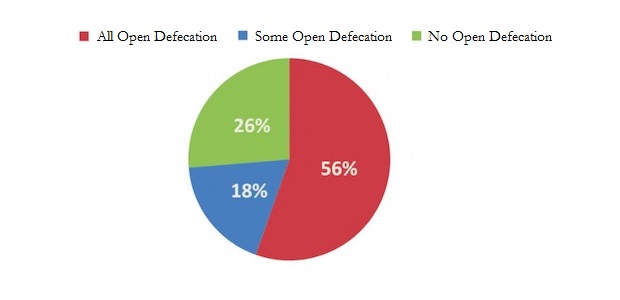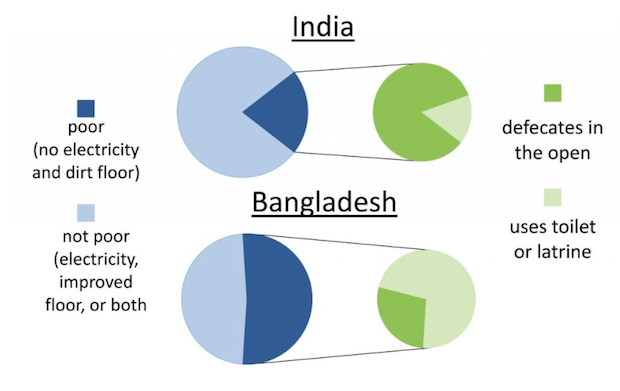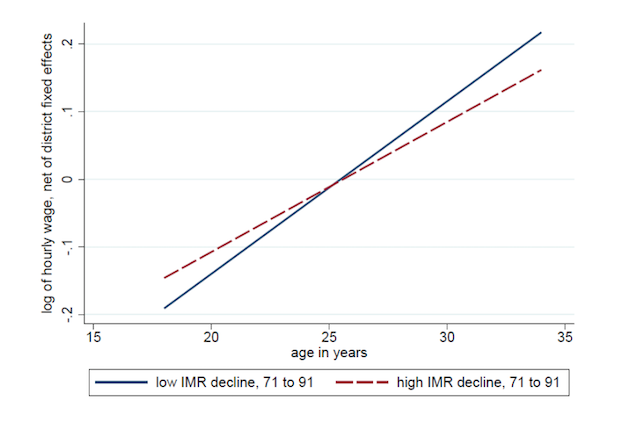‘Casteism Will Not Allow Swacch Bharat Abhiyan To Succeed’
American scholars Dean Spears and Diane Coffey, co-founders of the Research Institute for Compassionate Economics
Why are children in India shorter than children from other countries even those poorer than India? It was the urge to solve some of India’s development puzzles like this one that drew American scholars Dean Spears and Diane Coffey to India in 2009.
The couple co-founded the Research Institute for Compassionate Economics (RICE) in 2011 and settled in Sitapur, a rural district in central Uttar Pradesh, four years ago. With a population of 4.5 million people, it is the size of Sierra Leone and Liberia and has a similar infant mortality rate.
“Sierra Leone and Liberia have a health ministry, education ministry, a Unicef mission; Sitapur has none of that. So it made a lot of sense to go somewhere like that and add value," Spears stated in an earlier interview.
Spears and Coffey have a masters in public administration and completed their PhDs at the Princeton University. Spears specialised in economics and public affairs and Coffey in demography. The two met and fell in love when Spears was a teaching assistant in a statistics class where Coffey was a student. They got married in 2011.
Their research in India has established links between open defecation and high infant mortality in rural India. It has also exposed the caste prejudices that encourage open defecation. A surprising fact showed up in their study -- many people in rural areas, especially in north India, choose to defecate in the open even if they have a toilet at home. Many reasoned that it was a more ‘pleasant, comfortable and convenient’ option.
Their new book, Where India Goes: Abandoned Toilets, Stunted Development, and the Costs of Caste throws up many such insights that sanitation experts and administrators would never openly admit to.
Q: At least one person in 40% of rural households with latrines in Bihar, Uttar Pradesh, Haryana, Madhya Pradesh and Rajasthan defecates in the open, according to the SQUAT survey. Why do Indians hate to use latrines?
Spears: There are a few things that play into (the habit) —people like to wake up early in the morning and be in the field and it is considered manly. Some young women are kept in the house all the time, like a young daughter-in-law isn’t allowed to go outside. The biggest reason is casteism and people worrying about what will happen if the latrine pit gets filled up.
All around the world people use the simple pit latrine and when it gets filled, somebody has to empty it and either the family does it themselves or they hire someone to do it. It is unpleasant but it is not an enormously big deal. In India, it is an enormously big deal because it is associated with being a Dalit. The Dalits don’t want to be doing it either and they are looking at forward to a better future when they will be no longer oppressed.
Lot of families with latrines think that if they use them, it will pollute their home and they will never be able to empty them. To avoid all this, it is easier is to defecate in the open. It is going to be a hard problem to solve because it is rooted in these old and strongly held issues of social inequality.
Latrine Use Among All SQUAT Households
Source: R.I.C.E
Q: You talk of the connection between infant mortality rate (IMR) and sanitation in your book. Could this be the reason India’s IMR is falling at a slower rate than in poorer countries like Bangladesh?
Spears: If you live next to neighbours who defecate in the open, there are germs on the ground, lot of the people don’t wear shoes, they get their fingers on it [germs], their moms get their fingers on it and then there are flies on it and they get on the food and the entire environment is where is lot of faeces and there is lot of opportunity to get on germs.
One interesting thing is that it is not about your own household’s open defecation but your neighbour’s. People who live close to people who open defecate are more likely to die. In Bangladesh where open defecation is as less as 1%, the infant mortality rate is much lower than India even though it is much poorer than India. It is not the only reason but it is one of the important reasons.
Latrine Use Among The Poor: India vs. Bangladesh
Source: R.I.C.E
Q: Can you tell us how sanitation factors ensure that Muslim children have better chances of surviving in India than Hindu children?
Spears: There was a puzzle in health economics literature that within India, Muslim babies are more likely to survive infancy than Hindu babies. It is a puzzle because richer populations are healthier on average and on average, Muslim populations are poorer than Hindu populations in India.
It is not really about being a Muslim or Hindu baby at all because there is the same advantage of living next to Muslim neighbour. We were looking at what is so different about neighbourhoods where Hindu and Muslim live. We found that Muslim neighbourhood are less likely to have piped waters, less likely to have other state services than Hindu neighbourhoods. But, on average, there is less open defecation in Muslim neighbourhoods because they are more likely to have and use latrines than Hindu households.
Of course, (this is not the case) in all states but on an average children living with more Muslim neighbours are going to have healthier environments than people living with Hindu neighbours.
Q: For a long time, it was assumed that Indian women do not want to defecate in the open. Your book breaks that myth. Can you elaborate?
Coffey: This is complicated. For women whose families do not want them to defecate during daylight or who insist that they always be accompanied when they defecate in the open, it can be very helpful to have a latrine. Also, some women who grew up using latrines may marry into households that don't have them and they may feel uncomfortable defecating in the open. But our research suggests that in many parts of India, such women are in the minority. Many women are opposed to using affordable latrines with small pits, just like men. Also, open defecation is normal for women just like it is normal for men, so it is often not seen as the shameful or uncomfortable practice that city people assume it is. Finally, for some women, open defecation provides a welcome, socially-acceptable opportunity to get out of the house and walk around a bit. Such opportunities can be few and far between, especially for young women whose movements are often carefully monitored by their in-laws or husbands.
Q: How has open defecation impacted the health of Indian women?
Coffey: Research by Dean Spears and Josephine Duh shows that women who are more exposed to open defecation are thinner, on average, than women who live in villages and neighborhoods where more people use latrines. And underweight is an important health problem in India. It makes both men and women less productive. When pregnant women are underweight, babies are often born too small and are less likely to survive infancy. Further, my research with Dean Spears and Michael Geruso on the effect of open defecation on children's hemoglobin levels in Nepal suggests that open defecation likely contributes to high rates of anemia among men, women, and children in India, as well.
Q: What is the cost India is paying for this high incidence of open defecation?
Spears: It is hard to put a number on but one thing that we do is we look at a small part of it. If children are healthy when they are babies then they grow up stronger and taller, they are able to concentrate at school and learn more and they have higher achievement. Our whole workplace would be healthier if they were exposed to a healthier environment, including sanitation, as children.
We can see that in wage data. If we look at a survey like India Human development Survey and how much workers in India make, we find that adults are paid more and are more productive if they are born in a better disease environment. Their families get to consume more and they pay more taxes and government gets more revenue.
So what we do is that if you can cause a household to stop defecating in the open, just one household, there would be money in the future but it will be an equivalent of increasing the revenue of India by Rs 20,000 per household. That’s just looking at government’s revenue, but then the family gets to eat more, there is more productivity and they will be healthier and they will be more likely to survive.
What Doesn’t Kill You Makes You Poorer: Adult Wages And Early-Life Mortality In India
Source: R.I.C.E
Q: India’s high open defecation rates have less to do with poverty, literacy or governance. Your analysis is contrary to what most policy makers and sanitation experts believe. How did they react to it?
Spears: It is not like it came out in one moment, we had research papers in 2013, 2014 and we have been talking to lot of people over the years. When we talk to people in international development organisations, they often seem very surprised, especially if they are not from India or they maybe think it is offensive when we talk about it.
When we talk to a state or district government, they are not surprised. They may have not spoken about it but when we say it is about caste and untouchability, people from the state and district government who go out in the field and are in touch with village life are not surprised at all.
We were talking about the state-level secretary in rural government and we were giving him our presentation, he said: “Oh wow, I didn’t know this specifically that I could say it but I suspected it and now that you have said it, it just made things clear to me.”
Governments are good at building latrines.You had different political parties across the decades and rural sanitation has always been about building latrines. (But) this sort of issue which is about long-standing social attitude -- and when open defecation is common and it is something people believe in -- then it is hard for the government to do something about it.
Q: Gandhi spoke about this but in your view, why are beliefs related to sanitation and caste still strong when things around are changing?
Spears: In rural India, caste, caste system and untouchability are still important. If you see survey data on untouchability, lot of people say that they still practice untouchability and ghoongat (the veil used by married Hindu women). Many say that they would favour laws that will make it illegal for a high-caste person to marry low caste or Hindu (to marry a) Muslim.
As long as many people in India still believe in these things, when they think about latrine they (will) think about caste.
Q: Are there any strategies at all to stop open defecation?
Coffey: In the last chapter of the book, we have outlined some strategies that we think are worthy of experimentation. One is to challenge people's beliefs about latrine pits by teaching people how pit latrines work: how long it takes them to fill; and to make clear that emptying decomposed latrines is not the same thing as manual scavenging. Another is to experiment with ways of accommodating beliefs about latrine pits -- perhaps more of the government's subsidy could be spent on the pit alone and less on the superstructure. We also think that, in a diffuse but nonetheless important way, it would be useful for the government to address the manual scavenging that still exists and to raise awareness about links between casteism and poor sanitation.
Q: Is there a gradual change in our sanitation policy -- are we looking at behaviour change and creating a demand for the toilet first?
Spears: It is certainly something that policy documents talk about. Policy makers know that what matters is hundreds of block offices across dozen of rural districts actually organising something that changes the way people think about casteism. It is easy to sit in the office in a capital and write down on a paper ‘behaviour change’ what is hard is to actually find a way to change people’s mind about inequality.
Q: Has there been community-led total sanitation (CLTS) intervention in India?
Spears: There is not a lot of CLTS in India and I even think there is an important debate about how much it has contributed in other countries. For example we have a graph about it in our book about CLTS in Bangladesh.
CLTS was invented in 2000 and people talk about how it was an important part of what happened in Bangladesh. But open defecation in Bangladesh in 1991 was much less than what it is in India today. It was already going down in Bangladesh and if you look at open defecation before and after CLTS, it is going down at the same rate. That doesn’t definitely prove that CLTS doesn’t work but we need to think about it carefully.
In CLTS, people are supposed to come together as a community against open defecation. In most places, community means local area, my town or my village but in India, it means religion or caste.
The whole idea of CLTS is to get the whole village to cooperate but people in villages in India unfortunately don’t co-operate, especially ones where open defecation is common. Exactly the places where casteism is important, those are the places where open defecation is common and those are the places where there is a lot of conflict among castes.
Q: What happens in a scenario where everyone gets and actually uses a latrine?
Spears: Imagine if Swacch Bharat Mission was successful and magically everyone is using the latrines. In a few years, they are going to fill up and who is going to empty them? It is going to set back progress in social liberalism because, one way of the other, Dalits will be the people who have to empty the latrine pits. I don’t think there is a solution to the problem and I think it is problem that we should all be thinking about.
(Yadavar is principal correspondent with IndiaSpend.)
We welcome feedback. Please write to respond@indiaspend.org. We reserve the right to edit responses for language and grammar.
__________________________________________________________________
“Liked this story? Indiaspend.org is a non-profit, and we depend on readers like you to drive our public-interest journalism efforts. Donate Rs 500; Rs 1,000, Rs 2,000.”






